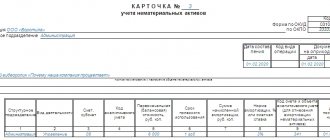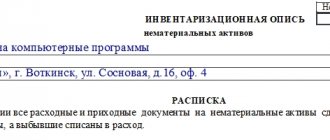PBU 14/2000 establishes a list of intangible assets, which includes rights to inventions, industrial designs and trademarks, as well as computer programs and databases. The business reputation of the organization and expenses for authorized and share capital are also classified as intangible assets. However, to classify an object as an intangible asset, a number of conditions must be met: its useful life must be more than 12 months, the organization must have all the necessary documents confirming its rights, benefit from the use of intangible assets in the present or future, and also use it for its own needs .
Accounting for intangible assets in 1C provides for the following operations:
- Acquisition and posting of intangible assets;
- Acceptance of intangible assets for accounting;
- Write-off of intangible assets in 1C 8.3;
- Inventory of intangible assets.
What applies to intangible assets
Under certain conditions, intellectual property objects (results of intellectual activity) can be taken into account as part of intangible assets. In particular:
- inventions, industrial designs, utility models;
- computer programs, Internet sites;
- trademarks and service marks;
- production secrets (know-how);
- breeding achievements (for example, for a grown plant variety or a bred animal breed).
In addition, the business reputation of the organization can be taken into account as part of intangible assets.
This is stated in paragraph 4 of PBU 14/2007.
The intangible assets of an enterprise cannot include:
- organizational expenses;
- intellectual and business qualities of personnel, their qualifications and ability to work.
Such rules are established by paragraph 4 of PBU 14/2007.
Example of filling out line 1110 “Intangible assets”
Let's give an example of how line 1110 “Intangible assets” of the Balance Sheet is filled out. Let’s assume that a certain LLC reflects investments in intangible assets separately, according to a separate line of Section I independently entered into the balance sheet. If the company receives insignificant investment indicators, the reflection is made on line 1190.
Values by count. 04 and counting 05 in the accounting of this LLC (in rubles):
| Index | As of December 31, 2014 |
| 1 | 2 |
| 1. By Dt. 04 | 1 970 500 |
| 2. According to CT account. 05 | 297 522 |
Fragment of the balance sheet for the previous (2013) year:
| Explanations | Indicator name | Code | As of 12/31/2013 | As of 12/31/2012 | As of 12/31/2011 |
| 1 | 2 | 3 | 4 | 5 | 6 |
| 1.1 | |||||
| 1.2 | Intangible assets | 999 | 1544 | 1422 | 759 |
| 1.3 |
The enterprise does not revaluate intangible assets.
Solution. The indicators for line 1110 will be as follows:
- 1,970,500 – 297,522 = 1,672,978 rubles – as of December 31, 2014,
- 1544 tr. – as of December 31, 2013,
- 1422 tr. – as of December 31, 2012.
In the Balance Sheet, completed line 1110 will look like this:
| Explanations | Indicator name | Code | As of 12/31/2014 | As of 12/31/2013 | As of 12/31/2012 |
| 1 | 2 | 3 | 4 | 5 | 6 |
| ASSETS | |||||
| I. NON-CURRENT ASSETS | |||||
| 1.1 | |||||
| 1.2 | Intangible assets | 1110 | 1672 | 1544 | 1422 |
| 1.3 |
Conditions for classification as intangible assets
An object of intellectual property can be taken into account as part of intangible assets if the following conditions are simultaneously met:
- the organization is the holder of exclusive rights to the intangible asset. At the same time, the existence of the object itself and the exclusive rights to it must be documented;
- the organization has the right to receive economic benefits from the use of the facility;
- the period of use of the object exceeds 12 months, and the organization does not intend to resell it for at least 12 months;
- the original (actual) cost can be reliably determined.
This is stated in paragraph 3 of PBU 14/2007.
The conditions for recognizing intellectual property objects as intangible assets are presented in more detail in the table.
If the conditions for recognizing an object of intellectual property as an intangible asset are not met (for example, if the organization has not received a patent for an invention or the useful life of the object is less than 12 months), then its value can be taken into account as part of:
- expenses for research, development and technological work (R&D);
- deferred expenses;
- current expenses.
conclusions
The receipt of an intangible asset by an enterprise is the starting point for its accounting. Documentation of the acceptance of such assets for accounting is of great importance for their further operation.
It is necessary to ensure that the company has title papers, correctly draw up accounting documents, accurately indicate all mandatory details, and register rights (if necessary).
The specifics of accounting procedures are significantly predetermined by the legal basis for the emergence of intangible assets - creation (development) or acquisition (purchase).
Rights to the created object
If an organization has created an object of intellectual property on its own, then the exclusive rights to it must be documented. Most intellectual property objects (results of intellectual activity) must be registered with Rospatent or the State Commission for Testing and Protection of Selection Achievements. Documents confirming exclusive rights to the created object are:
- certificate for a trademark (service mark) (Articles 1480 and 1481 of the Civil Code of the Russian Federation);
- certificate of exclusive right to the appellation of origin of goods (clause 2 of Article 1518 and Article 1530 of the Civil Code of the Russian Federation);
- patent for an invention, industrial design, utility model (Articles 1353 and 1354 of the Civil Code of the Russian Federation);
- patent for a selection achievement (Articles 1414 and 1415 of the Civil Code of the Russian Federation).
If the organization has received the necessary security documents, the created intellectual property object can be taken into account as part of intangible assets.
Some intellectual property objects are registered voluntarily, for example, the exclusive right to a computer program (Article 1262 of the Civil Code of the Russian Federation).
Intangible exploration assets on the balance sheet
This property also belongs to intangible assets, but for their accounting in the balance sheet, line 1130 is allocated, where the costs of searching, exploration and evaluation of mineral deposits are recorded. Regulates the accounting of exploration assets PBU 24/2011. Intangible exploration assets on the balance sheet are:
- the right to conduct search and exploration activities, confirmed by license;
- information generated as a result of various geophysical surveys;
- results of exploration drilling/surveying, collection of samples and specimens, other specific information about the subsoil;
- assessment of the market feasibility of development and production.
Exploratory intangible assets are reflected in the balance sheet and accounted for on account 08 “Investments in non-current assets” at their residual value - the debit balance on account 08 at the beginning of the period is reduced by the amount of the credit balance on account 05.
Rights to the transferred object
In addition to creating intellectual property on its own, an organization can obtain rights to them:
- under an agreement (license or alienation of an exclusive right) (Article 1233 of the Civil Code of the Russian Federation);
- in a non-contractual manner on the basis of the law (for example, during reorganization, foreclosure on the property of the copyright holder) (Article 1241 of the Civil Code of the Russian Federation).
In each of these cases, the organization acquires the rights to use the intellectual property. These rights may be exclusive or non-exclusive.
Depending on the type of agreement, an organization may receive all exclusive rights to an intellectual property object or only part of them.
To transfer all rights to an object of intellectual property, an agreement on the alienation of exclusive rights is concluded. In this case, the organization becomes the only one who can use the resulting intellectual property. This is stated in Article 1234 of the Civil Code of the Russian Federation.
If part of the exclusive rights to the result of intellectual activity is transferred, a license agreement is concluded. The license agreement can be of two types:
- simple (non-exclusive) license;
- exclusive license.
In the first case, the original owner of the exclusive right (licensor) reserves the right to issue licenses to other parties. That is, other organizations can also use this result of intellectual activity (means of individualization). In the second case, the organization is the only one who uses the object within the framework of the rights transferred to it. Such rules are established in Article 1236 of the Civil Code of the Russian Federation.
For example, a program for management accounting was developed at the request of an organization. According to the agreement, the organization has exclusive rights to use the program in its business activities, and the developer has exclusive rights to modify it. In such a situation, the developer does not have the right to provide the computer program for use by other persons, and the organization does not have the right to enter into agreements for modifying the computer program with other developers.
An object of intellectual property can be included in the intangible assets of a company only if the organization owns all the exclusive rights (for example, if an agreement on the alienation of an exclusive right was concluded or the organization became the copyright holder after reorganization). This follows from the provisions of paragraphs 38 and 39 of PBU 14/2007. To include the received object among intangible assets, you must have documents confirming exclusive rights. For example it could be:
- agreement on alienation of exclusive rights;
- transfer act (in case of reorganization in the form of transformation, merger or accession) or separation balance sheet (in case of division or separation of an organization) (Article 58 of the Civil Code of the Russian Federation).
The agreement must be registered with Rospatent (State Commission for Testing and Protection of Selection Achievements) in cases where the result of intellectual activity itself was registered (clause 2 of Article 1232, clause 7 of Article 1452, clause 5 of Article 1262 of the Civil Code of the Russian Federation) .
If only part of the exclusive rights to an intellectual property object has been received, then such an object is recognized as an intangible asset received for use. Since intellectual property objects received for use are not included in the organization’s balance sheet, it is necessary to maintain off-balance sheet accounting for them. This procedure follows from paragraphs 38 and 39 of PBU 14/2007.
The cost of the enterprise's intangible assets recorded on the balance sheet should be repaid by calculating depreciation (clause 23 of PBU 14/2007).
R&D
The costs of acquiring (creating) an object of intellectual property should be reflected as part of R&D if the following conditions are simultaneously met:
- the object was developed in-house by the organization or on its order;
- work to create an object can be classified as research or scientific and technical activities. The criteria for such activities are defined in Article 2 of the Law of August 23, 1996 No. 127-FZ;
- the result of R&D is not subject to legal protection or legal protection is not properly formalized (for example, if the invention does not require a patent or the organization for some reason did not patent its invention).
This follows from paragraph 2 of paragraph 1 and paragraph 2 of PBU 17/02.
Future expenses
If the cost of an intellectual property item cannot be reflected as part of R&D expenses, then the costs of its creation (purchase) should be included either in deferred expenses or in current expenses. The costs of acquiring (creating) an object of intellectual property that will be used in several reporting periods are considered as deferred expenses. For example, do this if, when purchasing the rights to use an object of intellectual property, the organization paid a fixed amount at a time. If this condition is not met, the costs of acquiring (creating) an object of intellectual property should be taken into account as part of current expenses. For example, do this if the organization makes periodic payments for the use of intellectual property. This procedure follows from paragraph 18 of PBU 10/99.
Costs for the acquisition (creation) of an intellectual property item, recorded as deferred expenses, are subject to write-off. The organization independently establishes the procedure for writing off expenses relating to several reporting periods. For example, an organization can write off a one-time one-time payment for the use of an object of intellectual property evenly over the period for which it was received. Fix the applied option for writing off deferred expenses in the accounting policy for accounting purposes. This is stated in paragraph 18 of PBU 10/99 and paragraphs 7 and 8 of PBU 1/2008.
An example of reflecting in accounting the costs of acquiring part of the exclusive rights to use a patented invention. For the use of a patented invention, the organization pays a fixed amount at a time
In January 2021, Alpha LLC entered into a license agreement with Proizvodstvennaya LLC (patent holder). Under the agreement, the organization receives part of the exclusive rights to use the patented invention for 2 years (24 months) - from February 1, 2021 to January 31, 2021.
Under the terms of the agreement, in January 2021, the “Master” is paid a remuneration in the form of a fixed one-time payment in the amount of 169,920 rubles, including VAT - 25,920 rubles.
Alpha's accounting policy states that deferred expenses are written off as current expenses evenly over the period to which they relate. In this case, during the validity period of the license agreement.
In accounting, Alpha's accountant made the following entries.
In January 2021:
Debit 012 – 169,920 rub. – the cost of an intangible asset received for use is taken into account;
Debit 97 Credit 60 – 144,000 rub. (RUB 169,920 – RUB 25,920) – remuneration accrued under the license agreement;
Debit 19 Credit 60 – 25,920 rub. – VAT on remuneration under the license agreement is taken into account;
Debit 68 subaccount “Calculations for VAT” Credit 19 – 25,920 rub. – accepted for deduction of VAT on remuneration under the license agreement;
Debit 60 Credit 51 – 169,920 rub. – remuneration under the license agreement is transferred.
Every month from February 2021, the accountant writes off (in proportion to the number of calendar days) part of the remuneration under the license agreement, taken into account as part of deferred expenses.
In February 2021:
Debit 20 Credit 97 – 5713 rub. (RUB 144,000: 731 days × 29 days) – part of the remuneration under the license agreement, previously taken into account as deferred expenses, was written off.
In March 2021:
Debit 20 Credit 97 – 6107 rub. (RUB 144,000: 731 days × 31 days) – part of the remuneration under the license agreement, previously included in deferred expenses, was written off.
The accountant made similar entries for writing off royalties under the license agreement, included as deferred expenses, until January 2021 (inclusive).
In January 2021, upon expiration of the license agreement, the accountant wrote off the value of the intangible asset acquired for use:
Credit 012 – 169,920 rub. – the value of an intangible asset received for use is written off.
An example of reflecting in accounting the costs of acquiring part of the exclusive rights to use a patented invention. For the use of a patented invention, the organization transfers monthly license payments
In January 2021, Alpha LLC entered into a license agreement with Proizvodstvennaya LLC (patent holder). Under the agreement, the organization receives part of the exclusive rights to use the patented invention for 2 years (24 months) - from February 1, 2021 to January 31, 2021.
According to the agreement, the cost of the intangible asset received for use is 169,920 rubles. Under the terms of the agreement, the “Master” is paid a monthly remuneration in the amount of 7,080 rubles, including VAT – 1,080 rubles.
The following entries were made in Alpha's accounting.
In January 2021:
Debit 012 – 169,920 rub. – the cost of an intangible asset received for use is taken into account.
Every month from February 2021 to January 2021, the accountant makes the following entries:
Debit 20 Credit 60 – 6000 rub. (RUB 7,080 – RUB 1,080) – remuneration accrued under the license agreement;
Debit 19 Credit 60 – 1080 rub. – VAT on remuneration under the license agreement is taken into account;
Debit 68 subaccount “Calculations for VAT” Credit 19 – 1080 rub. – accepted for deduction of VAT on remuneration under the license agreement;
Debit 60 Credit 51 – 7080 rub. – remuneration under the license agreement is transferred.
In January 2021, upon expiration of the license agreement, the cost of the intangible asset acquired for use was written off by the accountant:
Credit 012 – 169,920 rub. – the value of an intangible asset received for use is written off.







